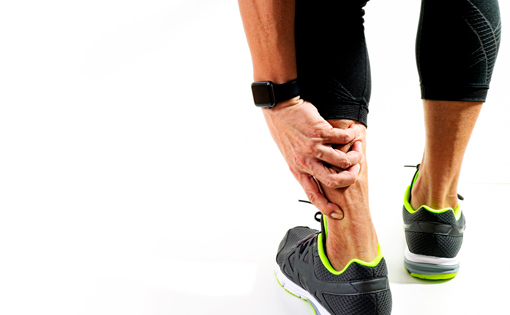BY MARK KINI
Recently, I played in a charity dodgeball tournament and badly strained my Achilles tendon. As a result, I have been limping around for almost two weeks with only modest improvement. Although I run several times a week and go to the gym routinely, I have never had an Achilles tendon issue before. Because dodgeball is like basketball with a lot of sudden stops and starts and side-to-side motion, this is not a movement my body was used to, particularly while playing for an extended period of time. Valuable—and painful—lesson learned.
 Sports and physical activities are essential for maintaining a healthy lifestyle, but they also come with the risk of injuries. Among the most common sports-related injuries are strained muscles and tendons, but sometimes, these can escalate into more serious issues such as tears. This guide will help you identify these injuries, understand their severity, and provide steps for effective recovery. Be aware that this is only intended as a basic primer. You should consult with a medical professional for a full analysis and treatment of your injury.
Sports and physical activities are essential for maintaining a healthy lifestyle, but they also come with the risk of injuries. Among the most common sports-related injuries are strained muscles and tendons, but sometimes, these can escalate into more serious issues such as tears. This guide will help you identify these injuries, understand their severity, and provide steps for effective recovery. Be aware that this is only intended as a basic primer. You should consult with a medical professional for a full analysis and treatment of your injury.
UNDERSTANDING SPORTS-RELATED INJURIES
1. Strained Muscles and Tendons
↹ Definition: A strain occurs when a muscle or tendon is overstretched or torn. This can happen suddenly or over time due to repetitive stress.
↹ Symptoms: Pain, swelling, muscle spasms, and limited range of motion.
↹ Common causes: Overuse, improper technique, sudden movements, or inadequate warm-up.
2. Muscle and Tendon Tears
↹ Definition: A tear is a more severe form of strain, where the muscle or tendon fibers are partially or completely torn.
↹ Symptoms: Intense pain, significant swelling, bruising, and inability to use the affected muscle.
↹ Common Causes: Sudden, forceful impact, heavy lifting, or severe overstretching.
3. Other Serious Injuries
↹ Definition: Includes conditions such as ligament tears (e.g., ACL tear), fractures, and dislocations.
↹ Symptoms: Severe pain, deformity, instability, and inability to bear weight or move the affected area.
↹ Common Causes: High-impact collisions, falls, or twisting injuries.
IDENTIFYING THE SEVERITY OF THE INJURY
1. Initial Assessment
↹ Pain and Swelling: Mild to moderate pain and swelling suggest a strain, while severe pain and rapid swelling indicate a possible tear.
↹ Range of Motion: Limited but possible movement usually points to a strain. Inability to move the area may signify a tear.
↹ Bruising and Deformity: Extensive bruising and visible deformity are red flags for more serious injuries.
2. Medical Evaluation
↹ Physical Examination: A health care provider will assess the injury through palpation, range-of-motion tests, and functional tests.
↹ Imaging Tests: X-rays, MRI, or ultrasound may be used to confirm the extent of the injury and rule out fractures or complete tears.
STEPS FOR RECOVERY
1. Immediate Care
↹ R.I.C.E. Method: Rest, ice, compression, and elevation are crucial in the first 48 hours to reduce swelling and pain.
↹ Pain Management: Over-the-counter pain relievers such as ibuprofen or acetaminophen can help manage discomfort and inflammation.
2. Rehabilitation
↹ Physical Therapy: A structured rehabilitation program guided by a physical therapist can help restore strength, flexibility, and function. This may include stretching, strengthening exercises, and modalities such as ultrasound or electrical stimulation.
↹ Gradual Return to Activity: Avoid rushing back to sports. Gradually increase activity levels under professional supervision to adapt movement again and prevent re-injury.
3. Surgical Intervention
↹ Indications: Surgery may be necessary for complete tears, severe ligament injuries, or when conservative treatments fail.
↹ Recovery: Post-surgical rehabilitation is critical. Follow your surgeon’s and physical therapist’s guidelines for optimal recovery.
4. Long-Term Prevention
↹ Proper Warm-Up and Cool-Down: Always include a thorough warm-up and cool-down in your routine to prepare your muscles and tendons for activity.
↹ Strength and Flexibility Training: Regularly engage in exercises that improve muscle strength and flexibility to support joint stability and prevent injuries.
↹ Technique and Equipment: Use proper techniques and appropriate equipment for your sport. Consider professional coaching or biomechanical assessments if needed.
Sports-related injuries like strained muscles and tendons are common, but with prompt identification and appropriate care, most individuals can recover fully. Recognizing the signs of more serious injuries and seeking timely medical evaluation is crucial. Through diligent rehabilitation and preventive measures, athletes can reduce their risk of future injuries and continue to enjoy their sports safely. [CD0724]
Mark Kini is the President & CEO of Boston Chauffeur. He can be reached at mark@bostonchauffeur.com.

